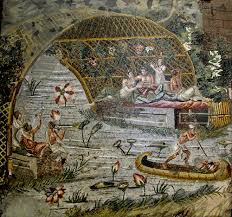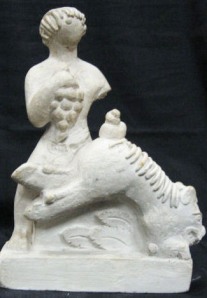Ancient Roman Jobs in Entertainment Artists:
Entertainment
Keeping the people of Rome was important especially in Rome which, due to the high number of slaves, led to the majority of Plebeians being unemployed and supported by the state. The Plebeians demanded entertainment. The jobs surrounding the entertainment industry included the oldest profession, prostitution.

The theatre played a large part in entertaining the masses with plays and mimes. Chariot racing was a highly lucrative profession. And of course, there were the gladiators. Many gladiators were slaves but some of these Romans chose this as a profession particularly the ex-soldiers looking for fame and glory. The chariot racing and gladiator combats also gave way to another favorite – gambling.
Artists
Artists were required to create sculptures, frescoes, and the fabulous Roman mosaics.

Everyone had a specific role in ancient Roman society and as such you could say they had a “job”. A basic understanding of ancient Roman jobs requires an understanding of the breakdown of the strict class system of Roman society.
What were the jobs in ancient Rome?
The ancient Romans worked extremely hard. To make the most of daylight, the majority of working Romans started their day at the crack of dawn. As the majority of the city’s lawyers were patrons, they were unable to start work until the third hour after sunrise. Romans tended to work until the sixth hour, midday when they ate a light lunch and took a siesta.

At the seventh or eighth hour, most men would return to work but those in the wealthier classes took the opportunity to visit the public baths and take part in some all-important socializing. After the ninth hour, these men would relax in preparation for the evening meal.
Ancient Roman jobs for the Poor
The quality of living in Ancient Rome did not only consist of the extremes; hugely wealthy or extremely poor. There were many who occupied the financial middle ground. Although this band was much narrower then than it is today, there were families of skilled tradesmen and craftsmen who lived perfectly comfortable lives.
Despite being strictly separated from Rome’s elite, they would have been able to afford moderate extravagances as well as a decent education for their children.
Roman Job Specialization
Architects, sculptors, and doctors were recognized as talented and valuable. Clothing and jewelry designers who catered to the expensive tastes of the elite were in high demand and those who succeeded in gaining a favorable reputation hardly went hungry. Slave dealers and breeders of fine horses are other examples of the success gained by shrewd businessmen in the upper middle class.

There is little known about those members of the lower working classes which were the majority of the Roman population who occupied the positions of menial labor. Those men and women would have hardly had time to document their lives, indeed many of them would not have known how. In a society built on slavery, it was difficult for a free man to hold a job when a slave could provide the same service for free.
Ancient Roman Jobs Facts
Nonetheless, free men often felt superior to the slaves doing the same job as they and, though members of the elite were so scornful towards the lower classes, the worlds in which they lived were so far removed from each other, a free man would rarely notice their existence.
Thus the ancient Roman Empire was a huge Empire. The occupations in ancient Rome extended to various spheres of the ancient Roman life. The occupations in ancient Rome differed from being political, military and social.



